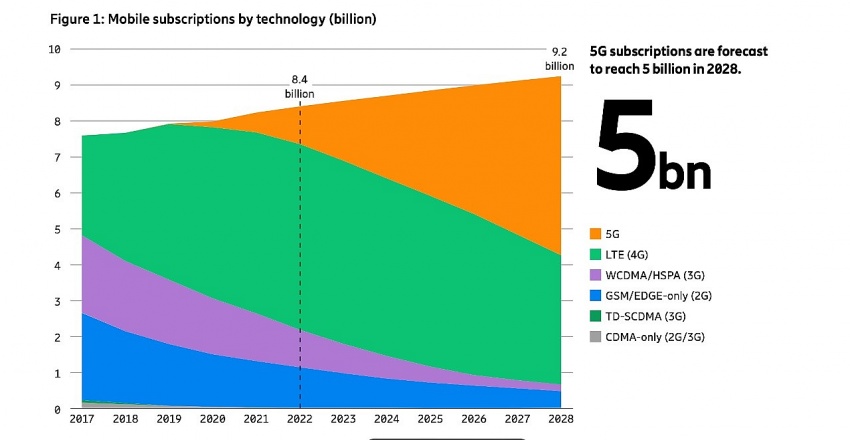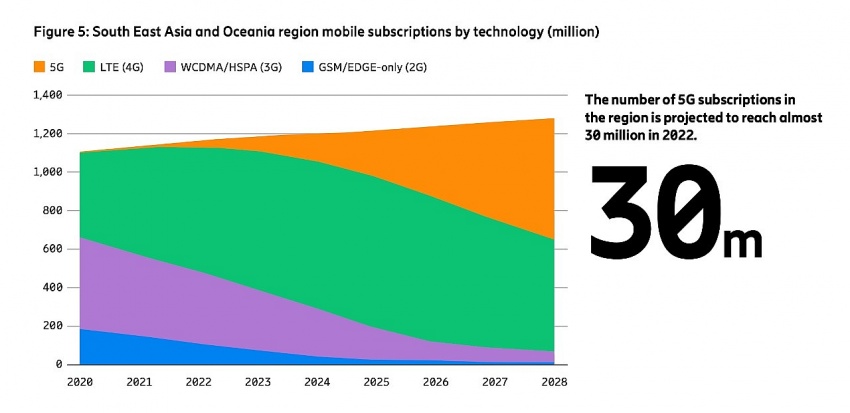5G to become leading technology in Southeast Asia
The report also forecasts global fixed wireless access (FWA) connections to grow faster than previously expected. FWA – the wireless alternative to wireline broadband connectivity for homes and businesses – is one of the major early 5G uses, particularly in regions with unserved or underserved broadband markets.
Driven in part by accelerated FWA plans in India, and expected growth in other emerging markets, FWA is forecast to grow at 19 per cent year-on-year through 2022-2028, and top 300 million connections by the end of 2028.
 |
More than three-quarters of communications service providers (CSPs) surveyed in more than 100 countries currently offer FWA services. Almost one-third of CSPs are offering FWA over 5G, compared to one-fifth a year ago. Almost 40 per cent of the new 5G FWA launches in the past 12 months have been in emerging markets
On 5G itself, about 110 million subscriptions were added globally between July-September 2022, bringing the total to about 870 million. As forecast in previous reports, 5G is expected to reach one billion subscriptions by the end of this year – two years faster than 4G did following its launch.
This reinforces 5G as the fastest-scaling mobile connectivity. Key drivers include the timely availability of devices from multiple vendors, with prices falling faster than for 4G, and China’s large early 5G deployments.
North America and North East Asia continue to see strong 5G growth, with 5G penetration in the regions expected to reach about 35 per cent by end of 2022.
Globally, almost 230 CSPs have launched 5G services to date, with more than 700 5G smartphone models announced or launched commercially.
By the end of 2028, five billion 5G subscriptions are forecast globally, accounting for 55 per cent of all subscriptions. In that same timeframe, 5G population coverage is projected to reach 85 per cent while networks are expected to carry around 70 per cent of mobile traffic and account for all contemporary traffic growth.
Global 4G subscription numbers also continue to rise, growing by about 41 million between July and September 2022. Global 4G subscriptions are expected to reach a peak of about 5.2 billion around the end of this year.
Overall mobile subscriptions are expected to top 8.4 billion by 2022 and 9.2 billion by the end of 2028. Most subscriptions are associated with smartphones. At the end of 2022, 6.6 billion smartphone subscriptions are estimated, accounting for about 79 per cent of all mobile phone subscriptions
Southast Asia and Oceania highlights
 |
In Southeast Asia and Oceania, it is expected that most major service providers will have launched commercial 5G services by the end of 2028. Subscriptions in the region are anticipated to reach around 620 million by the end of 2028, meaning it will become the leading technology in subscriptions, with a penetration rate of 48 per cent.
Denis Brunetti, head of Vietnam, Myanmar, Cambodia and Laos, Ericsson said, “4G and 5G will enable Vietnam to unlock the full potential of the Fourth Industrial Revolution and will be the critical national infrastructure and foundation upon which Vietnam can further build on its digital transformation journey, supporting the government’s vision and strategy in driving sustained socioeconomic development through science, technology and innovation.”
 | 5G can change the game in manufacturing As the fastest and most reliable connectivity enabler the world has ever seen, 5G will deliver an array of innovative uses to increase factory capabilities and boost agility. Denis Brunetti, president for Ericsson in Vietnam and Myanmar, explains why freeing operations from wire dependency is the best direction to take. |
 | Transforming healthcare through 5G Key findings within Ericsson’s ConsumerLab report, titled “From Healthcare to Homecare”, have outlined the potential of 5G to transform the healthcare sector globally and in Vietnam. |
 | Enterprises ramp up resilience in erratic world Enterprises are being proactive and resilient as they recognise that preparedness is critical in an increasingly erratic world, according to Ericsson’s new Future of Enterprises report that was released on October 11. |
 | Ericsson highlights consumer insights on the next wave of 5G adoption At least 510 million consumers across 37 markets will take up 5G in 2023, offering an exciting wave of opportunities for those that want to explore potential of 5G, according to Ericsson’s largest consumer study. |
 | Digitalisation to drive forward sustainable development Digital transformation is already a global engine of sustainable economic growth and, undoubtedly, 5G will be a socioeconomic driver for Vietnam. The enhanced speed, security, and resilience offered by 5G will provide stimulus for local industry to innovate and digitalise rapidly, creating significant economic value for the country. Connected, digital enterprises not only tend to thrive and generate jobs, but also contribute to increased revenues, as well as addressing climate change. |
What the stars mean:
★ Poor ★ ★ Promising ★★★ Good ★★★★ Very good ★★★★★ Exceptional
Themes: Digital Transformation
Related Contents
Latest News
More News
- Climate Finance Accelerator Vietnam begins search for projects seeking investment (December 18, 2025 | 17:22)
- Vietnam and Switzerland conclude SwissTrade (December 17, 2025 | 18:22)
- TECHFEST Vietnam 2025 links startups with policy and capital (December 15, 2025 | 18:21)
- MST to allocate $3.8 billion for sci-tech in 2026 (December 15, 2025 | 18:10)
- Long Thanh International Airport welcomes first Vietnam Airlines test flight (December 15, 2025 | 18:01)
- Health Innovation Hub: accelerating health equity through digital healthcare innovation (December 15, 2025 | 08:00)
- Vietnam’s first AI Law to take effect from March 2026 (December 12, 2025 | 09:00)
- Chi Communications joins SEA CAN alliance (December 11, 2025 | 17:39)
- New Law on High Technology sets incentives and safeguards (December 11, 2025 | 09:00)
- IBTE 2025 to return to Ho Chi Minh City this December (December 11, 2025 | 09:00)

 Tag:
Tag:


























 Mobile Version
Mobile Version